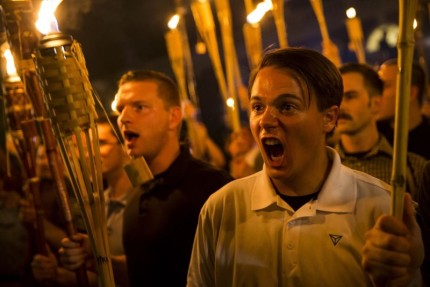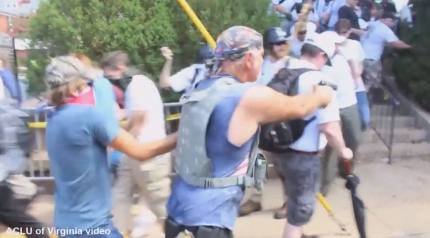This blog entry was originally published on the American Anthropological Associations (AAA) Blog. See url here:
By K. Nyerere Ture, PhD, Yale University
In January 2016, during the Republican primary season, Donald J. Trump, an emergent candidate, characterized his loyal supporters as the smartest Americans ever – the smartest to participate in electoral politics. Accordingly, most of these supporters were prepared to return America, substantively and symbolically, back to the practice of serving their (white) interests. To highlight his supporters’ decided loyalty towards his presidential ambition – a presidential campaigned vilely soaked with the bile of ultra-white nationalism – Trump publicly noted that he could, in effect, stand in the middle of Fifth Avenue (NYC) and shoot some anonymous person without the consequence of forfeiting his presidential run. Setting aside the absurdity here and the vague description of his shooting victim, his remark signaled two essential points that underpin white supremacy, namely the resulting spectacle of racialized violence and the racial and organizing construct of the logical utopia/illogical dystopia binary. These two elements were on full display during the Unite the Right rally in Charlottesville, Virginia. Additionally, the idea of spectacles of radicalized violence reminds me of Judith Butler’s foundational analysis of the Rodney King verdict.

First, given Trump’s spewed webs of xenophobia, racism, and misogyny echoed in Charlottesville, it is immediately clear to the mind of any casual observer that a suitable proxy for his imaginary victim is the marginally situated person categorized beyond the boundary of whiteness. To be certain, Trump’s declaration calls for and describes the spectacles of racialized violence in defense of white nationalism – in defense of whiteness. It is these spectacles that assault the psychosocial wellbeing of their implied and explicitly targeted victims. And yet, while these spectacles of racialized violence reflect real traumatic violence experienced at the corporeal level of the black body, with sensitivity I argue to take up an exclusive preoccupation with the spectacle distracts us from the more fundamental key factor of white supremacy, namely the logical utopia/illogical dystopia binary. This binary is a perceptual construct necessary to understand violent racism that operates across the American cultural landscape. It is a binary, which during its inductees’ uptake of social happenings, they schematically reconfigure those happenings according to racist perspective. To be clear, I do not intend to discount the existence of physical harm borne by victims of racialized violence; however, I do intend to redirect attention to the fact that the binary construct addressed here is the progenitor of the spectacles of racialized violence to begin with.

Nearly eight months into President Trump’s administration, serialized images of terroristic and racialized violence coming from Charlottesville were foisted upon us. I was struck by Richard Preston’s shooting incident in the Unite the Right rally that was eerily similar to what Trump prescribed during the 2016 Republican primary. Preston, a fifty-two-year-old, white male, of Baltimore County, Maryland stood in the middle of the street off the southwest corner of Emancipation Park, screaming the N-word, then removed his fire arm from his leg holster, readied it by cycling one round into the hand gun’s firing chamber, and then discharged that round at a crowd of counter-protesters. Point of fact, this was done just a few dozen feet away from present and attentive state and local police officers. As a former police officer (who now studies police and community relations), professionally trained in officer safety and to seek out social disorder and crime for applying various techniques of social control, apprehension and dare I say incapacitation of dangerous persons, I was dismayed by the absence of any immediate police response. Even further, when the serialized news footage of this incident went viral juxtaposed to the police response to Black Lives Matter (BLM) protests, the irony of inaction in Charlottesville versus militarized responses towards BLM carried a shrilling critique. Preston was arrested weeks later and inadequately charged with discharging a fire arm within one thousand feet of a school. It is important to understand that the serialized footage of Preston’s shooting was more than a broadcast of racialized violence. In addition, and perhaps instead, it was a palliative response to the anxieties generated by fear of racial threat to whiteness that accumulated/s in American culture and understood here through the logical utopia/illogical dystopia binary. This incident including the legal response provides sympathizers of White Nationalism, who are on edge by the presence of black life in this society notices of security. In other words, despite the horrific spectacle, for them the black threat is being contained. A particularly frightening consideration of the acceptance of Trump’s signal at the federal, state and local levels of police is the fact that they did not pursue Preston with the felonious aggravated assault with racial animus charge (hate crime).

The logical utopia/illogical dystopia binary, a perceptual and analytical construct to understand racial violence, particularly violence emanating from white supremacy. The logical utopia component orients cultural participants to see whiteness and all that appertains to it beyond reproach. Participants are socialized to see whiteness and those who possess this socially constructed asset as favorable, honorable, and even praiseworthy to the extent that despite witnessing actions that affront the good sense of civilized humanity, everyday citizens and well-trained police officers almost instinctually rework racialized violence against racial minorities into perceptually appropriate schematic narratives that favor whiteness. This includes spectating without perception of violent threats that endanger black life as exampled in Charlottesville. It literally places a premium on whiteness and white life and holds that a society exclusively white is both logical and ideal. On the other hand, the illogical dystopia component represents a condition – a coordination of perceptual facts whereby when the same above observer’s uptake of the most innocuous sorts of social practice performed by racially marginal societal members, it is instantly reconfigured into a schematic narrative that finds those actions morally opprobrious, contagiously villainous, perpetually dangerous, and inherently pathological. This culturally inscribed way of perceiving (dystopian gaze) warrants intensive interventions that can permanently incapacitate racial minorities. It leads to the irrational desirability of a society absent of blacks and other racially marginal determined citizens. President Trump was repeatedly pressed by national media to denounce the hate groups that organized the Unite the Right rally in Charlottesville and instead of doing so, he found tremendous fault in the counter-protesters whom he characterized as lawless reprobates.

The Unite the Right rally in Charlottesville, particularly within this Trump era, signals an invited return and a systematic acceptance for the public normalization of racially violent spectacles and gives a rare glimpse into the logics that undergird white supremacy. As a perceptual construct to better understand the roots of racially violent spectacles, the logical utopia/illogical dystopia binary shifts our gaze towards the more fundamental workings of whiteness suffuse within American culture. Anthropologists and other social-justice-oriented actors must read Trump, the Unite the Right rally, Richard Preston, and past and present spectacles of racialized violence as the culturally corrupt product of whiteness. Anthropologists possess within our wheelhouse of theoretical, methodological, and ethnographic tools, the greatest promise to expose these cultural patterns and to develop corrective interventions. Lest we accept this task of pragmatic solidarity with invigorative and critical interest, we are sure to witness many more varieties of racialized violence where we will be forced to mourn the imagined shooting victim vaguely described earlier, which is to say American democracy.
* Please see the AAA Blog site for the full series of commentary on Charlottesville and Race/Racism here: https://blog.americananthro.org/2017/09/18/charlottesville-trump-race-and-the-logical-utopiaillogical-dystopia-binary/
Also read Judith Butler’s “Endangered/Endangering: Schematic Racism and White Paranoia” article, which is a foundational article that influenced this piece.
Additionally, consider reading the powerful writing by Elijah Anderson http://sociology.yale.edu/people/elijah-anderson
